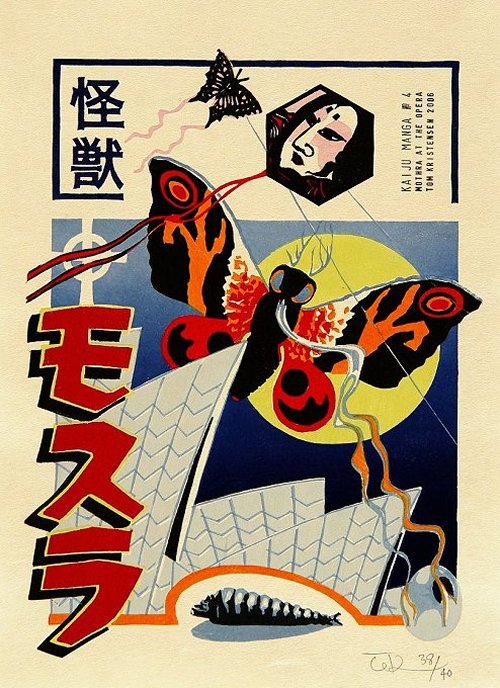| |
Tom CHRISTENSEN
|
|

"Mothra at the Opera"
Series: Kaiju Manga
2006
Comment - No. 4 of the Kaiju Manga
series, "Mothra at the Opera". Self-carved and self-printed by
the artist ("sosaku
hanga") on a thick Japanese "kozo washi" paper. Printed
with Japanese powdered pigments, gum and rice paste. The
woodprint carries two kites. A Rokkaku
kite (Sanjo
Rokkaku, ÈýÌõÁù½Ç), not
correctly bridled and with an unusual double tail and a butterfly kite (Ch¨
dako, µû„J). The Rokkaku carries a Japanese striking kabuki face with classical
make-up.
Chuang-Tzu once dreamed he was a butterfly. When he awoke, he no longer knew if he was a butterfly dreaming he was a man, or a man who had dreamed he was a butterfly. In 1961 the Toho film studios decided to follow the success of the Godzilla brand with Mothra the first of a dozen movies starring a giant moth with magical powers. As with other post-war Toho creations Mothra has an allegorical side. There is a critique of American capitalism and parody of religious worship. Mothra is Goddess and protector to the little people of radioactive Infant Island. She is summoned in times of threat by telepathy, musical prayer, dance and idolatry. Most often she is required to rescue a set of tiny singing twins. Mothra has a life cycle with four distinct phases. She will metamorphose from one stage to another to escape attack and arise like a phoenix from the ashes of destruction.
From a huge blue egg emerges the larva as a robust caterpillar with an appetite for destroying buildings and wrestling the enemy. When all seems lost the larva builds an impenetrable silken cocoon and enters the pupa stage. Inside the cocoon the caterpillar transforms into an enormous moth with striking symbols decorating her wings. Sheer size enables her to batter opponents and to generate destructive wind with the beat of her wings. Mothra also employs a death ray and as a last resort a shower of poisonous yellow powder rains from her wings. The shells of the Sydney Opera House are a beautiful realisation of natural forms in architecture. The geometry of the building can be derived from segments of an orange peel, while the shapes can be seen as sails, waves, or perhaps butterfly wings.
The Danish architect Joern Utzon has hinted that he took inspiration from swans on a lake. From the fable of the Ugly Duckling to the ballet of Tchaikovsky the swan is another changeling with wings. Like an actor on the stage, like a kite in the sky.
Series - Kaiju Manga
Artist - see Biography
Signature - "T.K" in pencil on the bottom margin; Edition - 38/40
Publisher - Tom Kristensen (sosaku hanga)
Image Size - 31.0cm X 22.0cm (12.2" x 8.7")
Condition - single sheet; Japanese kozo washi paper, mineral pigments, gum and rice paste.
Chuang-Tzu once dreamed he was a butterfly. When he awoke, he no longer knew if he was a butterfly dreaming he was a man, or a man who had dreamed he was a butterfly. In 1961 the Toho film studios decided to follow the success of the Godzilla brand with Mothra the first of a dozen movies starring a giant moth with magical powers. As with other post-war Toho creations Mothra has an allegorical side. There is a critique of American capitalism and parody of religious worship. Mothra is Goddess and protector to the little people of radioactive Infant Island. She is summoned in times of threat by telepathy, musical prayer, dance and idolatry. Most often she is required to rescue a set of tiny singing twins. Mothra has a life cycle with four distinct phases. She will metamorphose from one stage to another to escape attack and arise like a phoenix from the ashes of destruction.
From a huge blue egg emerges the larva as a robust caterpillar with an appetite for destroying buildings and wrestling the enemy. When all seems lost the larva builds an impenetrable silken cocoon and enters the pupa stage. Inside the cocoon the caterpillar transforms into an enormous moth with striking symbols decorating her wings. Sheer size enables her to batter opponents and to generate destructive wind with the beat of her wings. Mothra also employs a death ray and as a last resort a shower of poisonous yellow powder rains from her wings. The shells of the Sydney Opera House are a beautiful realisation of natural forms in architecture. The geometry of the building can be derived from segments of an orange peel, while the shapes can be seen as sails, waves, or perhaps butterfly wings.
The Danish architect Joern Utzon has hinted that he took inspiration from swans on a lake. From the fable of the Ugly Duckling to the ballet of Tchaikovsky the swan is another changeling with wings. Like an actor on the stage, like a kite in the sky.
Series - Kaiju Manga
Artist - see Biography
Signature - "T.K" in pencil on the bottom margin; Edition - 38/40
Publisher - Tom Kristensen (sosaku hanga)
Image Size - 31.0cm X 22.0cm (12.2" x 8.7")
Condition - single sheet; Japanese kozo washi paper, mineral pigments, gum and rice paste.
Copyright 2008 ff: Hans P. Boehme